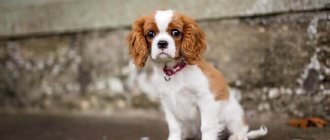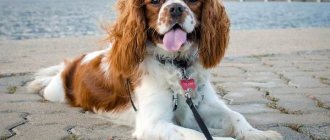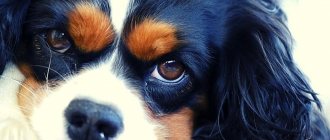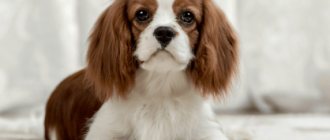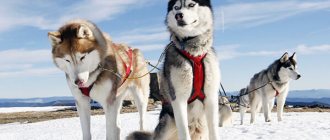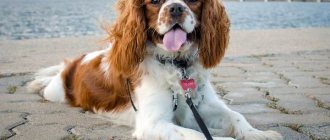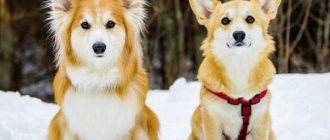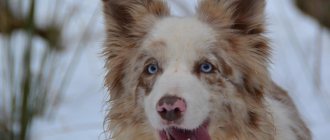Spaniels are a name that unites a large group of breeds, which includes Cocker Spaniels, Field Spaniels, Sussex Spaniels, Breton Espanolis, German Wachtelhunds and, of course, King Charles Spaniels.
King Charles Spaniels are dogs with an ancient history, formerly used for hunting, and later becoming favorites of kings and other representatives of the upper classes.
Today it is a popular breed of companion dog, ideal for both single people and large families with small children.
In our article you will find a comprehensive description of this wonderful dog breed.
History of the breed
The King Charles Spaniel is an ancient breed of dog whose history dates back to the 9th century, when dogs similar in appearance were brought to England by the Celts.
In the 13th century, during the reign of King Canute, representatives of this breed were used for hunting small game, but their attractive appearance and easy-going disposition were so liked by representatives of high society that after a few centuries they became simply companion dogs that lived at court. .
Miniature spaniels were the favorites of King Charles I - he was accompanied everywhere by 2-3 small dogs. Even a special decree was adopted, which is still in force today, allowing the king to be present in the House of Parliament along with spaniels. King Charles II, as a sign of respect for his father, named the breed after him.
In the 18th century In England, short-faced dogs brought from China and Japan became popular, so breeding work began on crossing cocker spaniels with chins and pugs .
Such matings changed the appearance of spaniels - the ears became lower, the head became more rounded, and the tail curved. Some changes have also affected the character of these dogs - they have become more independent and stubborn. The popularization of puppies with short muzzles led to the almost complete disappearance of the old type.
The first breed club was founded in 1885, at which time the official King Charles Spaniel standard was approved. In many other countries, particularly in the USA, representatives of this breed were called English mini or toy spaniels, so in 1902 the kennel club raised the issue of renaming the breed, but the king supported the request of its fans to preserve the historical name.
Description and standard
King Charles Spaniels are decorative dogs that have a well-balanced, strong and stable almost square body and retain the devotion to their owner that is inherent in working gun spaniels.
Breed standard:
- the head is rounded, the transition to a wide, short and slightly flattened muzzle is deep;
- the bridge of the nose is straight;
- the nose is pigmented black;
- the ears are hanging, wide at the base, not set too low;
- the eyes are round, set low and wide, the iris is dark;
- bite - snack;
- the neck is strong, short, the scruff is slightly convex;
- the chest is deep, not too wide;
- the back is straight, the croup is slightly sloping;
- the tail is long, can be curled into a ring, therefore it is often docked in order to maintain maximum length;
- limbs are strong, set parallel.
The coat is straight or slightly wavy, silky, and fits tightly to the body.
IMPORTANT!
Serious defects include fluffy, curly or trimmed hair, a scissor bite, an undershot or an excessive overshot that spoils the breed's facial expression.
Character traits
King Charles Spaniels are true companion dogs, devoted to their owner and all family members and requiring constant care.
Representatives of this breed are sociable and friendly, they love people and always strive to be the center of attention. At the same time, they are not intrusive; the main thing for them is simply to be close to the owner. King Charles are able to catch the mood of people and adapt to it, so they easily find a common language with all members of the household.
These dogs do not tolerate loneliness and lack of communication well. Lack of attention affects the mental state of the pet, which can become lethargic and lose interest in games and walks.
Like representatives of other breeds, King Charles Spaniels require early socialization and proper education; this is the only way to correct some of their character flaws. Training these dogs is quite simple - they are easy-going, smart and obedient, and their desire to please their owner further simplifies the training process.
However, they are not without some stubbornness and self-will, so sometimes they may refuse to follow a command, especially if they get bored. Therefore, training is best done in a playful way, but rude attitude and physical punishment should be avoided - such a disrespectful attitude of the owner towards the pet provokes destructive behavior in it.
King Charles spaniels are smart dogs, but talking about their training in the usual sense of the word is still wrong, since it is impossible to teach them complex commands and instill working qualities. But this is not necessary; nevertheless, the main purpose of representatives of this breed is to be faithful companions.
NOTE!
However, learning basic commands is not difficult and even beginners can cope with it. King Charles are attached to their owner and require his undivided attention. These are jealous dogs who get offended if they see that the owner’s attention does not belong only to them.
Education and training
Cavalier King Charles Spaniels are very smart and easily comprehend all the intricacies of the educational process, which does not prevent them from turning on the “misunderstanding” mode from time to time. Owners often fall for this canine trick and bombard specialized forums with questions like: “Why doesn’t the Cavalier King follow commands?” The reason for this behavior lies not in obstinacy of character, but in banal boredom. Perhaps you simply went too far with the severity and duration of training, tiring the dog. Or they simply did not take into account the peculiarities of her temperament.
Cavalier King Charles Spaniel on a leash
Dog trainers assure that the Cavalier King Charles Spaniel must be trained through play and as affectionately as possible. Most of these British “aristocrats” are characterized by innate timidity, so if you raise your voice during training, your pet may refuse to participate in classes forever. It is also not forbidden to stir up interest in training. For this, a supply of your dog’s favorite treats is enough.
“Cavaliers,” despite their rather gentle and peace-loving character, are not alien to some robber habits at heart. For example, if a dog encounters a cat or rodent on a walk, it will definitely try to chase it. Moreover, not every such “hunt” ends with the happy return of the pet. Captivated by the excitement of pursuit, the Cavalier King can easily get lost, so the commands “Ugh!” and “Nearby!” with a pet should be learned in advance and as firmly as possible.
From the age of 4-5 months, show-class Cavalier King Charles Spaniels begin to be accustomed to the show stand. First, the animal's success is rewarded with a treat. And only after the puppy has formed a stable association: stand = treat, you can use the command “Stop!”
Note: experienced handlers do not recommend teaching the “Sit!” command to the Cavalier King Charles Spaniel. until the animal takes part in exhibition events. Confused in an unfamiliar environment, the pet may confuse the meaning of the commands and, instead of the stance required from it, give the opposite action.
Lover to lie on the sofa
Advantages and disadvantages
For city dwellers who dream of a pet, the main advantage of these dogs is the ability to keep them even in small apartments.
Also they:
- smart and quick-witted;
- quickly become toilet trained;
- not too active, although they need daily walks;
- love children;
- get along with other pets;
- do not require labor-intensive care;
- loyal;
- friendly.
Among the disadvantages are noted:
- inability to be used as watchmen and security guards;
- jealousy and resentment;
- poor heat tolerance.
In addition, representatives of this breed need constant attention and are prone to developing eye diseases and ear problems.
Character and behavioral characteristics
The most striking feature of the mini spaniel's character is his involvement in the family. He is everywhere and everywhere. Such a dog needs communication; if left alone at home, it literally suffers and can act out.
Gentlemen often suffer from excessive timidity and can “withdraw into themselves” if the owner allows himself to be rude. However, they love everyone around them and are not suitable for the role of a security guard. They allow themselves to bark a lot and loudly, especially from an excess of feelings.
Photo: pixabay.com
Differences from the Cavalier Charles King Spaniel
Representatives of these breeds are very similar to each other, but there are some differences in appearance:
- unlike Cavaliers, whose skull is almost flat, Charles Kings have a domed skull;
- these dogs are quite snub-nosed, this is unacceptable for gentlemen;
- According to the standard, Charles Kings should have a slight undershot, and Cavaliers should have a scissor bite.
King Charles Spaniels are also smaller dogs and their body weight is also slightly less.
Breed traits
Breed traits (on a 5-point scale)
| Cavalier King Charles Spaniel | |||
| Activity | in the house | 1.5 | |
| on the street | 2.5 | ||
| Obedience | training | 4 | |
| strangers | 3 | ||
| Domination | in family | 1.5 | |
| over dogs | 1 | ||
| Defending your territory | from people | 1 | |
| from dogs | 1 | ||
| Sociability | in family | 5 | |
| with strangers | 2 | ||
| with dogs | 3 | ||
| Concentration | in family | 1 | |
| in front of strangers | 3 | ||
| with dogs | 2 | ||
| Aggressiveness | in family | 1.5 | |
| to strangers | 1.5 | ||
| to the dogs | 1.5 | ||
| to cats | 1.5 | ||
| Family behavior | calmness | 5 | |
| demand for affection | 5 | ||
| excitability | 2.5 | ||
| playfulness | 3 | ||
| excessive barking | 1.5 | ||
| behavioral breakdowns | 1.5 | ||
| Tolerance for children | up to 4 years | 3 | |
| over 4 years old | 4 | ||
| Institutional use | watchman | 2 | |
| bodyguard | 1 | ||
This breed is often compared to the following dog breeds: American Cocker Spaniel, Papillon, Beagle, Pomeranian, Yorkshire Terrier.
The photo shows what a Cavalier King Charles Spaniel looks like:
Photos and descriptions of colors
There are only 4 officially registered and approved breed standard coat color options for King Charles Spaniels.
Black and Tan
The rich coat is jet black in color with distinct ruby tan on the cheeks and chest, on the inside of the ears, paws, under the tail and above the eyes. The presence of white spots on the chest is undesirable, but is not considered a serious defect if they are small, but white marks in other places are unacceptable.
Important! There must be scorch marks in all standard places.
Ruby
The coat is a rich red color; the decorating hair may be slightly lighter.
A complete absence of white marks is desirable, but their presence in the chest area is not considered a gross defect.
Blenheim
The main color of the coat is pearly white, with patches of bright chestnut color on it that have clear boundaries. These marks should not merge; the presence of a pearl background between them is mandatory.
On the head, the arrangement of chestnut spots should form a white mark in the shape of a regular triangle, inside which there may be a so-called “Blenheim mark” - a small spot of ruby red color.
Tricolor
The coat is black and white with tan. With this color, the coat has a pearly white color, on which, at a sufficient distance from each other, there are coal-black spots with clear boundaries. Tan is located above the eyes, inside the ears, on the cheeks and under the tail.
Breed varieties
As for intrabreed varieties, there are none among the Cavaliers. Conventionally, dog handlers themselves divide representatives of the breed into four types based on coat color. You can determine what species a pet belongs to by the shade of its fur.
Color and coat type
Conventionally, the Royal Cocker Spaniel breed is divided into four types based on the type of coat color. These include:
- Dogs with the King Charles color, distinguished by an anthracite background, black and tan spots, clear boundaries between the eye spots, places around the tail, chest, cheeks. White spots are considered to be a defect of the species.
- Dogs with ruby fur, which is characterized by a uniform dark red or bright red color with a mahogany tint.
- Dogs with a Blenheim-type coat, which is represented by pearly white shades, symmetrical chestnut-colored spots, and a white diamond-shaped frontal blaze.
- Representatives of the Prince Charles (tricolor) color breed. The peculiarity lies in the black “glasses” on the eyes, pearly white fur, small tan marks, and symmetrical spotting.
Attitude towards other pets and children
Representatives of this breed do not strive to prove their superiority even to other dogs , and the docile nature of King Charles Spaniels and their lack of inclination to dominate and assert leadership positions help these dogs establish friendly relationships with other animals, including cats and rodents.
Their friendly disposition and innate curiosity determine their ability to get along with children. They treat kids well, love to play with them and can tolerate any pranks without showing aggression or even trying to bite the child.
Families with small children can have such a pet without fear; parents will need to rather control the baby, who through negligence can harm the dog, and not vice versa.
Application
The main purpose of a gentleman for several centuries has been to be a companion. He will not make a watchman or security guard - the pet loves people too much.
Moreover, this is not a dog of one owner. He is equally gentle and courteous with all family members, their relatives, friends and passers-by. Some owners scold their “traitors,” but that’s their character.
The dog can be used for short hunting or its imitation. He willingly picks up a bird, chases wild rodents, and “fishes.”
How to properly care?
Proper care of King Charles spaniels involves timely deworming, treatment for external parasites and vaccinations according to schedule. You also need to visit the veterinarian every six months for routine examinations, which will determine the presence of the disease and begin timely treatment.
In addition, it is necessary to regularly carry out hygiene procedures to help maintain the dog’s attractive appearance and health.
Wool and bathing
This breed does not require haircuts or trimming, but the fur on the paw pads and between the toes should be trimmed regularly to prevent dirt from accumulating.
The coat of King Charles Spaniels rarely becomes matted, however, it must be thoroughly brushed with a soft brush several times a week - this will not only completely eliminate the likelihood of matting, but will also help get rid of dead hairs and improve the pet’s blood circulation.
After each trip outside, it is necessary to wash and inspect the dog’s paws for cracks and damage.
You need to bathe her completely, using shampoo appropriate for her coat type, once every 1-2 months. It is better to avoid more frequent washing so as not to dry out the coat and spoil its natural structure.
Ears
The structure of the ears of representatives of this breed causes the accumulation of dust and dirt in them, which, coupled with insufficient ventilation, creates a favorable environment for the development of infection and bacteria.
You need to clean your pet’s ears with cotton swabs and pads soaked in peroxide or a special product every 5-7 days, and ventilate them daily.
Eyes
Every morning, wipe with clean lint-free napkins soaked in warm boiled water, chamomile infusion or weak tea leaves.
IMPORTANT!
If severe souring or increased lacrimation is detected, it is necessary to show the dog to a veterinarian.
Teeth
You can avoid the possibility of plaque and tartar formation by brushing your teeth weekly with a special brush and toothpaste designed for dogs. Giving your pet fresh tomatoes and chewy treats is also helpful.
Claws
King Charles spaniels are active dogs; with enough walks in the summer, their nails wear down on their own. If this does not happen, and also in winter, they must be shortened with a guillotine nail cutter once every 3-4 weeks, not forgetting about the dewclaws, if any.
Life expectancy and major diseases
King Charles Spaniels live on average 10-12 years, but some members of the breed can live for 14-16 years .
These dogs have a short muzzle, which explains their poor tolerance to hot weather and humidity, and also causes some breathing problems, particularly snoring.
King Charles Spaniels are also prone to:
- heart valve defects;
- intervertebral disc diseases;
- aseptic necrosis of the femur;
- cryptorchidism;
- hydrocephalus;
- cherry eye;
- epilepsy;
- glaucoma;
- retinal dysplasia;
- conjunctivitis;
- dry eye;
- cataracts;
- turning up the eyelids.
In addition, due to poor ventilation of the ears, representatives of this breed often develop ear infections, and some individuals may have a genetic abnormality called drooping tongue syndrome.
It should be remembered that these dogs have weak joints, so even a careless jump from the sofa or excessive physical activity can lead to dislocation of the kneecaps.
At the first manifestation of symptoms of pathology, it is necessary to show your pet to a veterinarian - only he will be able to make the correct diagnosis and prescribe the necessary treatment.
How to buy a Cavalier King Charles Spaniel puppy
To buy a purebred gentleman, it is better to contact a nursery. The breed is common in our country, but the price of puppies is quite high. Show class specimens cost 50-100 thousand rubles. You can buy a pet for yourself with minor flaws in appearance for 20-30 thousand rubles. It is better not to purchase puppies from advertisements or from other people. Representatives of the breed often have hereditary diseases. A professional nursery guarantees that the animals have been checked by a veterinarian.
When purchasing, you need to check all documents: pedigrees of parents, certificates from exhibitions, veterinary certificates. It is important that animals are kept clean. Mom should not be exhausted, aggressive or cowardly. Healthy puppies are curious, playful, and easy to interact with.
The photo shows what the puppies look like:
Interesting videos about Cavalier King Charles Spaniels:
Video: Owners talk about the Cavalier King Charles Spaniel breed
Video: Cavalier King Charles Spaniel: how to choose a puppy
Cavalier King Charles Spaniels are small, intelligent and loyal dogs. They live quietly in a small apartment, do not need much physical activity, and are suitable for inexperienced dog breeders. It is the best companion for the elderly, children. He is obedient, loyal, cheerful and unpretentious.
Nutritional Features
The main thing you need to know about the nutrition of King Charles Spaniels is that it should be balanced and contain all the necessary vitamins and minerals. These can be natural products or industrial feeds - the choice depends on the owner.
With natural feeding, the dog owner himself chooses the products for the dog and controls their quality. However, difficulties may arise in preparing a balanced diet, since without certain knowledge of veterinary nutrition it is impossible to do this.
The menu should include:
- lean meat (beef, veal, turkey);
- offal (tripe, lung, heart, liver);
- cereals (rice, buckwheat, oatmeal);
- vegetables and fruits;
- quail eggs;
- sea fish;
- low-fat fermented milk products (cottage cheese, yogurt, natural yogurt, kefir).
It is forbidden to feed your pet:
- fatty meat;
- river fish;
- citrus fruits;
- potatoes;
- legumes;
- spicy and fried foods;
- pickles, marinades;
- sausages, pasta and bakery products.
It is also necessary to give the dog a small amount of vegetable oils to improve the condition of the coat.
Industrial food allows you to save time on preparing food for your dog and does not require additional vitamin and mineral complexes, since their composition is enriched with all the necessary macro- and microelements.
NOTE!
When choosing food for your pet, you should take into account that it should be premium, super-premium or holistic class. Representatives of this breed are prone to allergic reactions, so the composition should not contain wheat or chicken. In addition, food must be selected taking into account the age, activity level, physiological state and health of the dog.
The most suitable diets for King Charles Spaniels are developed by the brands Probalance, Savarra, Pro Plan, Royal Canin, Go, Acana.
Choosing a nickname
Oddly enough, but choosing a worthy nickname for a girl or boy of this breed is quite difficult. On the one hand, the dog is cheerful, spontaneous and active, which dictates the choice of a simple and affectionate name. On the other hand, being "royalty" requires a name that sounds like a title.
Names with Japanese or Chinese sounds have become popular among the owners of these dogs.
For girls : Akana, Rowena, Akina, Yukki, Shinuka.
For boys : Locky, Rockwell, Tuxie, Amethyst, Rocky, Lando.
Photo: wikimedia.org
Sample menu for the week
| Day of the week | Morning | Evening |
| Monday | 100 g beef, 50 g greens, and 100 g oatmeal + 1 tsp. vegetable oil | 150 g turkey, 100 ml kefir, 200 g vegetables |
| Tuesday | 150 g of boiled sea fish, 100 ml of natural yogurt and 100 g of stewed vegetables with 1 tsp. vegetable oil | 100 g beef, 100 g cottage cheese and 100 g buckwheat porridge |
| Wednesday | 150 g offal, 100 ml kefir and 50 g herbs | 250 g offal, 80 g cottage cheese and 80 g stewed vegetables with 1 tsp. vegetable oil |
| Thursday | 150 g cottage cheese, 30 g herbs and 1 egg | 300 g beef, 100 g stewed vegetables and 80 g rice porridge |
| Friday | 150 g offal, 100 ml kefir and 50 g herbs | 250 g offal, 80 g cottage cheese and 80 g stewed vegetables with 1 tsp. vegetable oil |
| Saturday | 150 g of boiled sea fish, 100 ml of natural yogurt and 100 g of stewed vegetables | 100 g beef, 100 g cottage cheese and 100 g buckwheat porridge |
| Sunday | 100 g beef, 50 g greens, and 100 g oatmeal | 150 g turkey, 100 ml kefir, 200 g vegetables |
How to choose? Boy or girl?
You should not buy a King Charles Spaniel puppy from someone else or from an advertisement. Only professional breeders in specialized nurseries can guarantee the purity and health of pets.
At about 30-40 days after birth, the puppies are weaned from their mother, and at 8-12 weeks they are ready to go to a new home.
IMPORTANT!
It is important that the puppy meets the breed standard and has no defects in appearance or developmental abnormalities. He should not have a rash, increased lacrimation, swelling on the joints or ribs, twisted limbs, dandruff, lameness and other symptoms of the development of pathologies.
Representatives of this breed already have pronounced sexual dimorphism at an early age - males have a larger head and a compact body, while females are more graceful, but their body is more elongated, which is due to the need to bear offspring. The character of a dog does not depend on gender.
Diseases
Cavaliers are not distinguished by good health; we can identify the main diseases that are inherent in the breed and occur quite often:
- heart pathologies;
- Chiari syndrome;
- inflammatory diseases of the paraanal glands;
- allergic reactions;
- prolapse;
- joint dislocation;
- arthritis;
- hernias;
- episodic falling syndrome.
At the first signs of allergic reactions in a puppy, it is recommended to choose hypoallergenic food.
Peculiarities of the breed include the frequent occurrence of false pregnancy in bitches. In addition, if pathologies are identified in an animal, it is not recommended to breed, at least until the health problems are resolved.
Photo: pixabay.com
Price range
How much a puppy of this breed costs is influenced by its color, which club it belongs to, whether it has documents and any deviations from the standard or developmental defects and a number of other factors.
On average, for a black and tan puppy that meets the standard you need to pay 35-45 thousand rubles, tri-color puppies cost about 45-50 thousand rubles, a ruby King Charles spaniel will cost 25-35 thousand rubles, and baby with a Blenheim coat – 25-30 thousand rubles.
Price
The cost of these status pets cannot be called low. In prestigious Russian nurseries their price can reach up to 55 thousand rubles. Some champion dogs are sold from 65 thousand rubles.
But, if “pedigree” is a word that doesn’t mean anything to you, we recommend saving money and buying a puppy from a private breeder. The main thing is to make sure that it is well built and looks healthy. The price of a Cavalier Charles King Spaniel from private owners is from 7 to 10 thousand rubles.
Nurseries in Russia and CIS
King Charles Spaniel kennels:
- "Candy Nice", Russia, Moscow;
- “From the Queen’s House”, Russia, Moscow;
- Evidence Love, Russia, St. Petersburg;
- "Elchair", Russia, St. Petersburg;
- “Russian Pride”, Russia, Moscow;
- “Large Pav”, Russia, Moscow;
- “Russian Footprint”, Russia, Moscow;
- Beauty of An, Russia, Volgograd;
- Amantem Redamare, Belarus, Minsk;
- Royal Delight, Ukraine, Nikolaev.
How much do puppies cost?
The price for affectionate companions is steep. The cost of pet-class puppies is from 35,000 rubles, breeding – from 60,000 rubles. It is impossible to say how much a show class costs: they are sold for 80, 100 and more thousand rubles.
You can buy a puppy from breeding parents in the following nurseries:
- https://royal-suite.ru – Moscow;
- https://www.evidence-love.com – St. Petersburg.
Pets are popular in Europe and America. In Russia, the breed is only gaining momentum. It has its pros and cons. But dogs are predicted to have a great future in the CIS countries because of their flexibility, cheerfulness, beauty and easy care.
